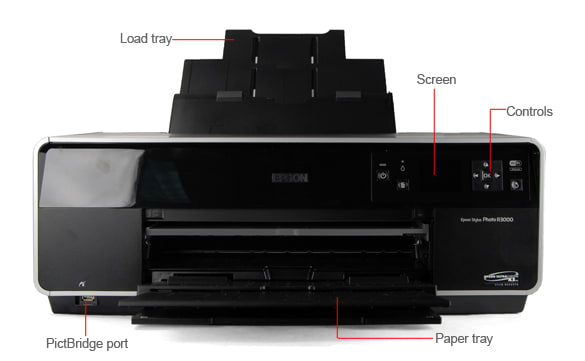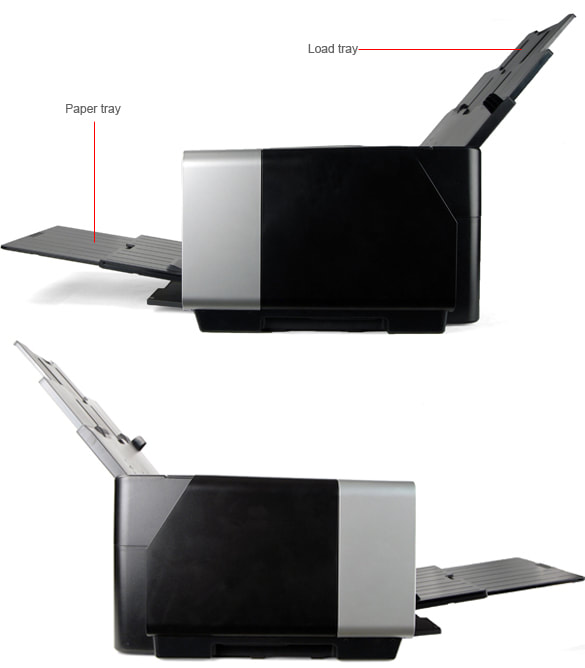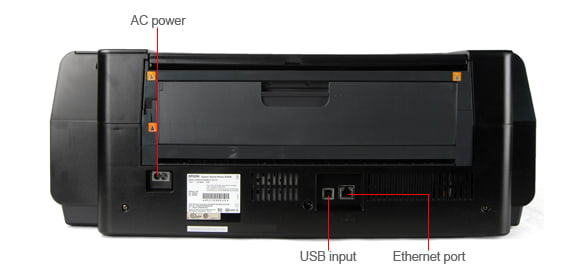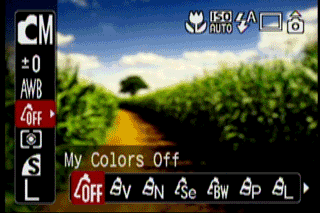Pros
Cons
Introduction
Tour & Design
Front

Side

Back

Ink Cartridges
The R3000 uses 9 total ink cartridges, 5 for color, and 4 for black and shades thereof. with each cartridge running about $30, it's a small blessing (or $270 blessing) that the printer comes with a set ready to go. Despite the high price, Epson claims that their 25.9 mL capacity will let you print more with each cartridge, but as with any printer capable of making large prints, your mileage may vary.
In the Box
As well as the printer itself, you get:
- A complete set of 9 ink cartridges
- A spool adapter for larger rolls of paper
- Setup and driver utilities
- An instruction manual that covers the basics.
Not included (annoyingly enough) is a USB cable, so you'll have to find your own, unless you use your wireless home network to set up the printer. Also not included is photo paper.
Software & Setup
Setup & Manuals
The Epson R3000 was surprisingly very easy to set up: once you've unpackaged the unit, installed the ink cartridges, the only somewhat annoying step is to set up the wireless network (if you don't have the appropriate USB cable. After running the setup utility, you should be all set to print after about 20 minutes, tops. If you would like a more detailed version of the installation process, the included manual covers each step beautifully.
Drivers
The software utility contains drivers for users of both Mac and Windows systems, although the pictures below are from the Mac version of the software.
It's worthy of note that you can construct your own color profiles tailor-made to your needs, unlike on older Epson models (namely the R1900). You can then select these profiles in supported programs when you execute the print command.
Software
The only additional software that Epson includes with its drivers is its Print CD utility, allowing users to print on compatible CDs and DVDs.
Print Speed
Photo Print Speed
The Epson R3000 doesn't set any speed records with its photo printing, but then again, if you want quality, what did you expect? For a 5 by 7 photo, it takes 8 minutes, 17 seconds to make one print, and for a 4 by 6 photo it takes 7 minutes 26 seconds. Not the worst we've seen, but it definitely isn't very fast. In addition to this slow speed, there will always be a sizeable white border, turning your 8.5 by 11 photo into an 8.25 by 10.5.
For those who absolutely must have the best quality in their printed photos, prepare to wait. We're not kidding: a 4 by 6 photo can take up to 1 minute and 36 seconds per print. It's not that speedy, but you probably won't waste away in anticipation either. For more on how we test print speeds, see this page.
Document Print Speed
The Epson R3000 isn't a speed demon printing documents, either. Still, it posts a fairly respectable speed of about 2.59 pages per minute, or a single document page every 23.16 seconds. If you need something faster than this, there is a faster setting that will crank out pages at one page ever 12.2 seconds, or 4.92 pages per second, but at a significant reduction in detail and color.
Print Initialization
Surprisingly enough, the R3000 actually has a very short initialization time, though it will try to align itself and make sure it's working properly the first time you start it up. It doesn't seem to like to do that automatically unless it's after a particularly large print, but all things considered, it takes very little time at all for the printer to be turned on and printing.
Color Performance
Color Accuracy
Good printers, you'll find, produce colors that are true to their original source image; no matter if it is a snapshot from a party or a piece of modern art. Bad printers produce inaccurate colors with problems like color shifting. We found that the R3000 did a decent job of replicating color values, although it's certainly nothing earth-shattering, it should be sufficient.
To measure color performance, we print out 24-color color charts on different settings and then measure the color values using a high-end spectrophotometer. Once we've done this, we recalibrate the printer and try again on the printer's custom paper and IlfordGalerie paper and measure again. For more details on how our color accuracy tests are done, see here.
The chart below shows the results: the number in each of the color patches is the CIDE 2000 color difference. The bigger this number, the larger the difference between the original and the printed color is to the eye.

NOTE: Because of the way computer monitors reproduce colors, the images above may not match the results used for evaluating color accuracy. The chart should be used to judge the relative color shift, not the exact printed colors.
Color Gamut
When we talk about color gamut, we're referring to the total range of colors the printer can output. Using the Adobe RGB color gamut as a reference point, we found that the Epson R3000 was able to produce only about 42.7% of the total Adobe RGB color gamut, which is a decent score for a low-end printer, much less so for a higher-end one. It should be mentioned, however, that very few printers at all score above 50% here. For more details on how we measure color gamut, see here.
Detail Performance
Detail Performance Summary
- Produces, solid, deep blacks
- Details are well rendered, but some prints are rather too heavy on the black
Depth of Blacks
When we test for depth of blacks, we're looking at the density of blacks produced by our units in print. The higher the print density, the darker and ultimately better the blacks will appear in terms of contrast between the ink of the printer and the white of the paper. In this test, the Epson R3000 has an absurdly good depth of blacks, with a Dmax measurement of 3.02, which is astoundingly good. For more details on how we test the depth of blacks in prints, see here.
Detail
One of the major points hyped by Epson for their R3000 model is the fact that it can reproduce very fine detail in images, and it certainly didn't disappoint. Printers still have a long ways to go before they reach the ideal response, but as you can see from the sample scans below, the R3000 did not have any difficulty in reproducing color strips without banding or other errors, and each image preserves a high level of detail. For reference, we print all of our test images with the highest DPI setting available, sacrificing print speed for quality.
We didn't see any issues with the color gradients, as there were no issues with banding or artifacting.
Sample Scan Comparisons

Looking at the sample scans above, it seems that the R3000 managed to produce a very good amount of detail without too many errors or artifacts: the Alice is well-rendered, and the dog's handsome visage is unblemished. Still, it's not perfect, as the forehead of the dog loses some detail, and the white angle suffers some loss of differentiation at its border.
Inks & Media
Ink/Toner
The R3000 uses 9 ink cartridges, 5 for color, 4 for blacks and shades thereof. Given that you're probably not going to use this printer for documents, it's not surprising that the quiver of cartridges is geared to printing high-quality photos with a slightly higher ink capacity.
Epson did not provide any information on how many prints you are likely to get from each paper size, but there's a good chance that largely has to do with the fact that this printer can handle many sizes, so your mileage may vary wildly. In our tests, we managed to go through hundreds high-quality prints without running out of ink, so these should last you a while. At roughly $270 for a full set of cartridges, that's a blessing.
Ink/Toner Management
In the past, we've found that Epson is rather aggressive about getting you to purchase more of their ink, but so far we haven't run into any of these pleasant little warnings that we need to go out and buy more right now.
On the ink management screen, you can monitor the levels of each cartridge, and disable the eventual warnings that may annoy you in the future.
You can also monitor your ink levels on the printer itself, if you don't feel like digging for the utility on your computer.
Media
Given that this is a very large photo printer meant to handle all sorts of paper sizes and thicknesses, it's no surprise that it can handle a very wide range of media, may it be an envelope, or a roll of paper on the spool attachment.
All of the standard paper sizes, along with some not-so-standard sizes are supported up to 13 inches in width; the drivers can support a litany of sizes, including 4 by 6, 5 by 7, 8 by 10, 8.5 by 11.5, a variety of letter sizes, and 13 by 19. If that's not enough, with the spool adapter you can use a roll of paper up to 32 feet long.
On top of all that, you can even print on fabric, or make transfers that you can put on fabric. You can also print on CDs or DVDs if you use the included adapter. This is definitely a good printer for artists looking to print on as wide a variety of media as possible.
Paper Storage
As with most printers, there is only one place to load the paper into the machine, and that is in the paper load tray located at the rear of the printer. Depending on your choice of paper, the tray itself can hold a varying amount of sheets; up to 120 sheets of regular printer paper, or 30 sheets of photo paper. Try to avoid leaving photo paper in the load tray for long periods of time, as this exposes them to dust.
Controls & Connectivity
On-printer Controls
Despite having a small LCD screen to help you control and adjust your printer settings on the unit itself, most of the controls for the printer actually live in the driver utility itself. Regardless, using the on-board controls you can have our printer re-calibrate, clean its nozzles, and control your network options. It is a pain, however, to enter in security passwords without a real keyboard.
On-Printer Display
There is really nothing spectacular about the on-printer display of the R3000, as it's nothing more than a tiny LCD display for those who don't really like their driver utility all that much; there isn't a whole lot that the screen is necessary for outside of setting up your network preferences over WiFi.
On-Printer Menus
As a result of having such a tiny screen, the on-printer menus are rather basic and uninspiring. Because the screen is so small, it is a bit difficult to read the text, especially at a distance. Thankfully, you won't be using it all that often.
Media Slots
Aside from a front-facing PictBridge port, there are no additional media slots. The PictBridge slot allows the Epson R3000 to interface directly with an external media source via a USB connection.
Wireless & Network
With the R3000, you can send data over your local area network wirelessly, though we recommend using a USB cable instead just in case something happens to the signal. The printer connects relatively fast, and remembers passwords, so you shouldn't get too frustrated with the utility. In our lab, we didn't seem to have any issues with the wireless.
Epson Stylus R1900 Comparison
Performance
The Epson R3000 didn't blow the Epson R1900 out of the water in color performance, but it is a decent step-up from the older Epson printer. The R3000 also has a much better dMax measurement, allowing it to surpass the older R1900 easily in performance. Still, the R1900 is the faster printer, so you'll have to decide if the tradeoff in performance is worth it.
Inks & Media
Both printers are exceptional in their support for different media, as the R3000 and the R1900 both can handle a wide range of paper sizes and printable media (eg DVDs etc.) The R3000 has one more ink cartridge than the R1900, and slightly increased volume per cartridge, but beyond that, the two printers are remarkably similar in this regard. Both are also capable of making borderless banner prints with their spool attachments for the back of the printers themselves.
In Use
Both printers are very easy to use, as their interfaces are simple and easy to navigate. This is where the similarities end, however, as the R1900 is a bit speedier on its highest print quality setting, as you can see in the crats below. Still, don't take that to mean that the R1900 is a quick printer, it just isn't quite as slow as its newer cousin.
Canon PIXMA Pro 9500 Mark II Comparison
Performance
The Canon Pro 9500 Mark II lags a little bit behind in color performance, and doesn't even sniff the performance of the Epson E3000 in terms of dMax. While it loses the color performance battle by a slim margin, it loses the speed battle by a large one: if you thought the R3000 was slow, the Canon Pro 9500 Mark II is even slower.
Inks & Media
TKBoth printers have a dizzying array of ink cartridges, but the Canon has 10, and the R3000 has 9. Despite the differing number of ink cartridges, they both have the standard magenta, cyan, and yellow, as well as some shades of a number of these.
Where they start to differ wildly is the types of media they can handle: unlike the Canon Pro 9500 Mark II, the Epson R3000 is capable of banner prints, and it is also capable of printing onto compatible DVDs and CDs, whereas the Canon can only print labels. If you require versatility in your printer, the Epson R3000 is tough to beat.
In Use
The Epson R300 is slow, but the Canon Pro 9500 Mark II is horrendously so. Beating the Canon by minutes rather than seconds, the molasses-slow R3000 whizzed by the Canon in our speed tests, even if both printers are thoroughly uninmpressive in this category.
HP B8850 Comparison
Performance
The Canon Pro 9500 Mark II lags a little bit behind in color performance, and doesn't even sniff the performance of the Epson E3000 in terms of dMax. While it loses the color performance battle by a slim margin, it loses the speed battle by a large one: if you thought the R3000 was slow, the Canon Pro 9500 Mark II is even slower.
Inks & Media
Both printers have a dizzying array of ink cartridges, but the Canon has 10, and the R3000 has 9. Despite the differing number of ink cartridges, they both have the standard magenta, cyan, and yellow, as well as some shades of a number of these.
Where they start to differ wildly is the types of media they can handle: unlike the Canon Pro 9500 Mark II, the Epson R3000 is capable of banner prints, and it is also capable of printing onto compatible DVDs and CDs, whereas the Canon can only print labels. If you require versatility in your printer, the Epson R3000 is tough to beat.
In Use
The Epson R300 is slow, but the Canon Pro 9500 Mark II is horrendously so. Beating the Canon by minutes rather than seconds, the molasses-slow R3000 whizzed by the Canon in our speed tests, even if both printers are thoroughly uninmpressive in this category.
Conclusion
The Epson Stylus R3000 is a great printer for the modern artist who needs to be able to print on a wide variety of media and needs to maintain a high level of detail. While the R3000 handles detail in a superb fashion, it suffers from average color performance, despite its amazing black level.
Performance:
Overall the performance of the R3000 was great: it handled printing in high DPI very well, it's efficient and versatile, and its black depth is out of this world. Its color gamut is a little weak for its price range, but this is its largest blemish in performance.
Inks & Media:
With a dazzling array of inks, you will certainly not be able to operate on a budget, but buyers of the R3000 are probably more concerned about quality over cash left in their pockets. With the drawback of ink cost, you will see a massive upside to the impressive array of media the R3000 can print on, including DVDs, cloth, thick posterboard, photo paper and regular old printer paper. If you get this printer for its versatility alone, you won't be disappointed.
Meet the tester
A seasoned writer and professional photographer, Chris reviews cameras, headphones, smartphones, laptops, and lenses. Educated in Political Science and Linguistics, Chris can often be found building a robot army, snowboarding, or getting ink.
Checking our work.
Our team is here to help you buy the best stuff and love what you own. Our writers, editors, and experts obsess over the products we cover to make sure you're confident and satisfied. Have a different opinion about something we recommend? Email us and we'll compare notes.
Shoot us an email